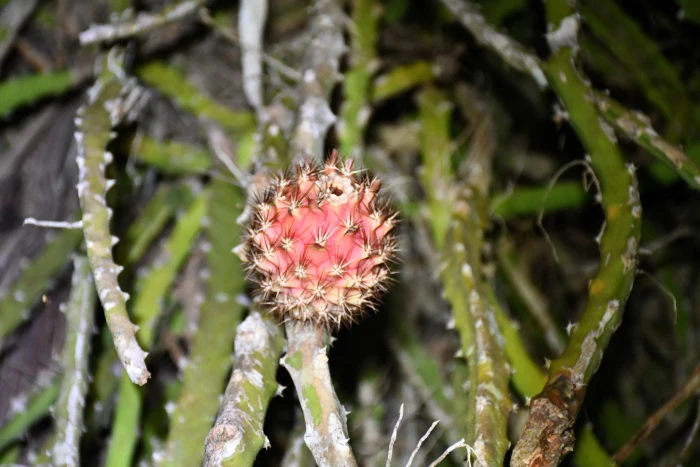Fishbone Cactus
(Selenicereus setaceus)
Fishbone Cactus (Selenicereus setaceus)
/
/

Vincent A. Vos
CC BY 4.0
Image By:
Vincent A. Vos
Recorded By:
Copyright:
CC BY 4.0
Copyright Notice:
Photo by: Vincent A. Vos | License Type: CC BY 4.0 | License URL: http://creativecommons.org/licenses/by/4.0/ | Rights Holder: Vincent A. Vos | Publisher: iNaturalist | Date Created: 2024-01-21T21:35:58-08:00 |

























Estimated Native Range
Climate Requirements
| • Precipitation | 49" - 59" |
| • High Temp. | 82°F - 90°F |
| • Low Temp. | 52°F - 66°F |
Summary
Selenicereus setaceus, commonly known as the Fishbone Cactus, is a perennial, epiphytic cactus native to a variety of habitats including subtropical or tropical dry forests, moist lowland forests, and rocky areas in Argentina, Bolivia, Brazil, and Paraguay. It is a climbing or sprawling plant that uses aerial roots to attach to surfaces. The Fishbone Cactus can reach lengths of several meters under ideal conditions. Its stems are slender and produce lateral branches that resemble a fish’s skeleton, hence the common name. The plant is known for its nocturnal, large, white flowers that bloom for a single night and are highly fragrant, attracting pollinators such as bats and moths.
In cultivation, Selenicereus setaceus is valued for its unique, ornamental appearance and its low-maintenance requirements. It is often grown in hanging baskets or as a climbing plant with support, making it a popular choice for indoor gardens and terrariums. It thrives in well-draining soil, requires moderate watering, and prefers bright, indirect light or partial shade. While it is not prone to many diseases, root rot can occur if overwatered. This species is not typically invasive when grown outside its native range, but care should be taken to avoid overly humid conditions that can promote fungal growth.CC BY-SA 4.0
In cultivation, Selenicereus setaceus is valued for its unique, ornamental appearance and its low-maintenance requirements. It is often grown in hanging baskets or as a climbing plant with support, making it a popular choice for indoor gardens and terrariums. It thrives in well-draining soil, requires moderate watering, and prefers bright, indirect light or partial shade. While it is not prone to many diseases, root rot can occur if overwatered. This species is not typically invasive when grown outside its native range, but care should be taken to avoid overly humid conditions that can promote fungal growth.CC BY-SA 4.0
Plant Description
- Plant Type: Vine
- Height: 5-15 feet
- Width: 2-5 feet
- Growth Rate: Moderate
- Flower Color: White
- Flowering Season: Summer
- Leaf Retention: Evergreen
Growth Requirements
- Sun: Full Sun, Part Shade
- Water: Medium
- Drainage: Medium, Fast
Common Uses
Bee Garden, Butterfly Garden, Edible*Disclaimer: Easyscape's listed plant edibility is for informational use. Always verify the safety and proper identification of any plant before consumption., Low Maintenance, Showy Flowers
Natural Habitat
Native to subtropical or tropical dry forests, moist lowland forests, and rocky areas
Other Names
Common Names: Hairy Pitaya, Pitaya Peluda
Scientific Names: Selenicereus setaceus, Cereaster setaceus, Cereus bifrons, Cereus coccineus, Cereus hassleri, Cereus lindbergianus, Cereus lindbergianus, Cereus lindmanii, Cereus lindmanii
GBIF Accepted Name: Selenicereus setaceus